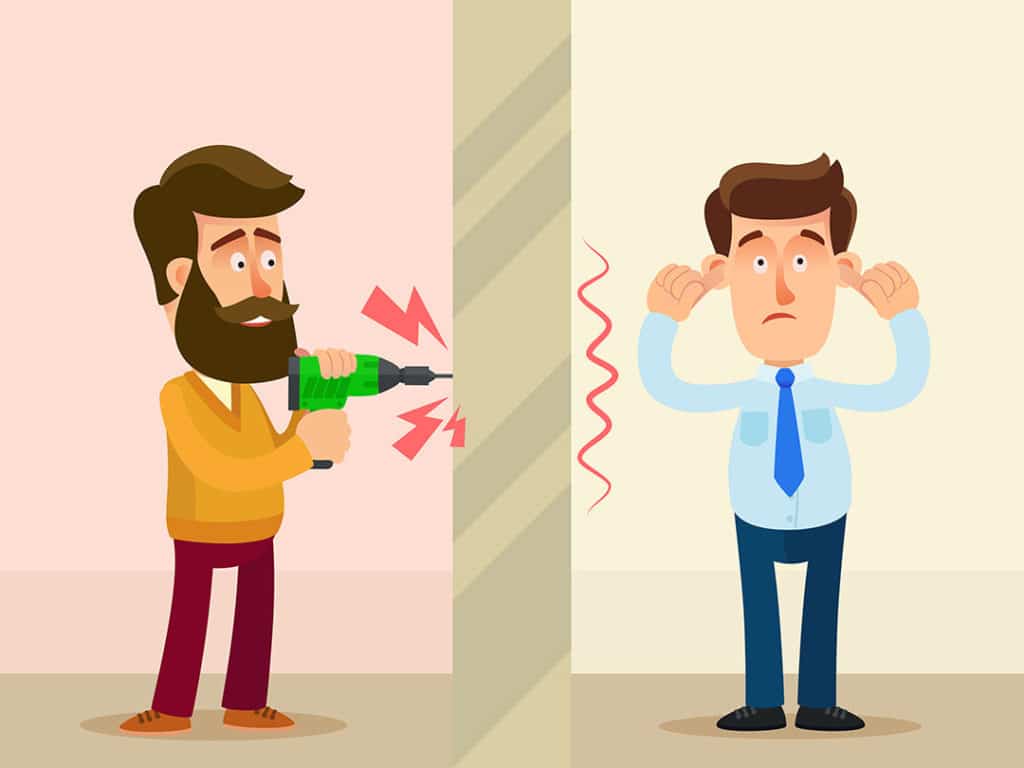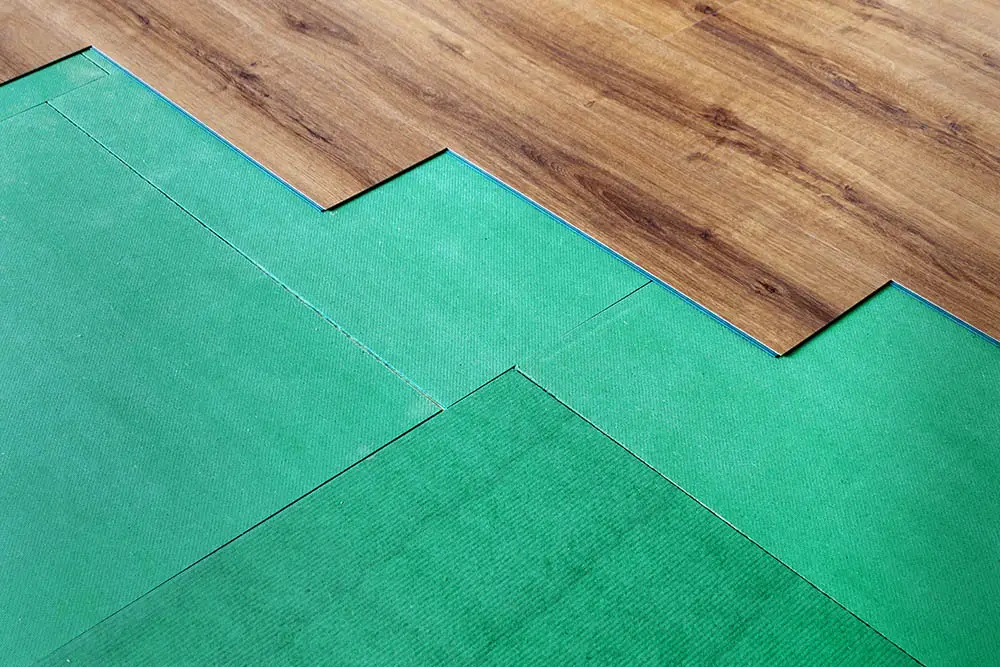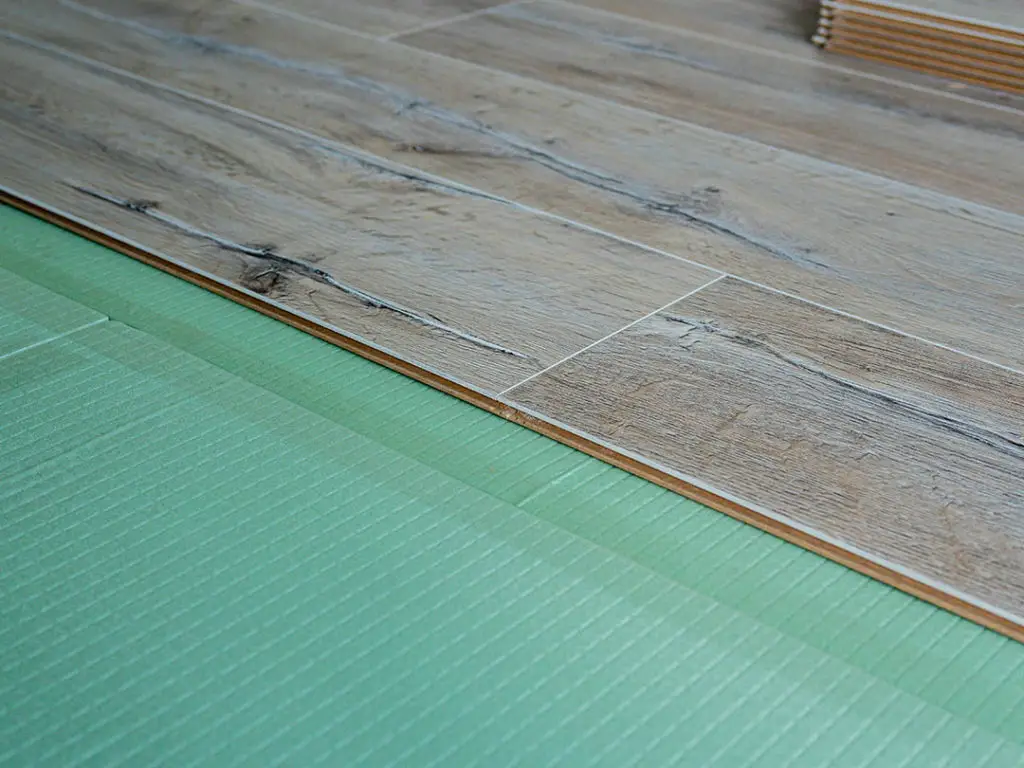Soundproof flooring materials reduce the transmission of noise between rooms and floors of homes and buildings. Examples of this product include underlayment for hardwood floors and padding for carpets.
Although soundproof flooring materials aren’t required as part of the installation process, a home becomes much louder without them.
If there is no insulation between an upper and lower floor, the lack of underlayment or padding can make it seem as if someone upstairs is next to your downstairs.
Soundproofing the floor reduces those issues. It can also help to limit HVAC sounds and other common household noise pollution problems.
First Step: Identify the Noise Type
Several sounds interfere with a home’s interior environment. You may hear music from another room, background sounds outside, or an air-conditioner unit turning on.
These sounds transmit in three common ways through a building. They can be airborne, structural, or flanking, based on how you interact with the noise.

■ What Is Airborne Noise?
Airborne sound (noise) is an audio wave transmitted through the air until crashing into a solid object. The collision creates vibrations that human hearing can detect. Ears can also pick up unobstructed soundwaves, with the brain translating them into specific sounds.
When you speak with someone over the phone or in-person, the voice you hear comes from airborne sound.
Watching TV, going to the movies, or having a car honk at you when you missed a stop sign are all examples of the same principle.

■ What Is Structural Noise?
Structural sounds occur when an object hits a solid surface to create vibrations. As the energy moves through wood, metal, concrete, or other materials, human hearing still detects the original audio pattern. It turns that into an accurate noise representation.
What makes the structural sound unique is its echoing effect. Imagine someone stomping their foot on a hardwood floor in their upstairs bedroom. That person hears an airborne sound.
Anyone on the ground floor would hear a structural sound. The vibrations create an echo that makes the noise seem louder to them than it would to the person in the bedroom.

■ What Is Flanking Noise?
Flanking noise (sound) transmits indirectly between spaces. Instead of going through a structure or directly to an individual, it wraps around an obstacle. Separated soundwaves do not have the same energy as a direct transmission, but they still transmit detectable audio.
Flanking noise is a challenge to deaden for soundproof flooring materials because the audio waves attempt to bypass the dampening features of the installation.

What to Look for in Soundproof Underlayment?
The best soundproof flooring materials use impact deadening features to reduce airborne, structural, and flanking sounds. The installed product should be dense to offer audio insulation while remaining porous to avoid trapping air above or below it.
Most underlayment products are made of foam, rubber, or cork because of those requirements. Some vinyl options are also available today.
Here are the traits that you’ll want to review before selecting the best soundproof flooring materials for your installation.
■ Material Density and Thickness
The thickness of an approved soundproof flooring material typically offers a reflection of its overall quality. If the content is made from foam, rubber, or cork, the densest and thickest item you can afford will provide the noise pollution reductions you want.
Choosing a soundproof flooring material with a vapor barrier is helpful because moisture or condensation can enhance structural vibrations. Allowing your floor to resist droplets ensures a quieter environment is achievable.
Any underlayment product is better than nothing at all. Thinner products may not block every generated audio wave. Still, they will keep a structure quieter than a floor without it.
■ Sound Transmission Class (STC)
The Sound Transmission Class (STC) rating of foam, rubber, cork, and some vinyl underlayment is a measurement of its ability to reduce airborne noise.
This measurement does not reflect the product’s ability to stop structural or flanking noise once installed.
A higher number is typically better when evaluating the STC of the underlayment. You must shop for this product based on its thickness, floor compatibility (hardwood vs. carpet), and other individualized features.
It helps to choose the product with the highest STC rating that meets your needs and is affordable to create a positive outcome.
■ Impact Insulation Class (IIC)
A non-insulated hardwood floor provides an Impact Insulation Class (IIC) rating of 45 or less. Most building codes require it to be 50 or higher. That means underlayment is a necessity for a home or another structure to pass its building inspection.
The IIC rating measures structural sounds that transmit through the floor. Although a proper underlayment won’t eliminate all noises generated by this method, it should stop a majority of them – especially in the mid-range frequencies.
This underlayment option works best when it can be installed along floor joists as they transmit more vibrations than the sub-flooring, hardwoods, tile, linoleum, or carpet.

Best Soundproof Underlayment to Install
If you are remodeling a home or finishing a new construction project, having the best soundproof flooring materials available can increase the quality of the final installation, these are the ones I’d recommend because of their high-quality materials, manufacturing, and craftsmanship:
- Roberts Super Felt Premium Underlayment
- Feather Step 3-in-1 Silent Vapor Barrier Underlayment
- Floor Muffler Ultra-Seal Underlayment
- Quiet Walk Laminate Floor Underlayment
- Roberts First Step Underlayment
- Roberts Felt Cushion Roll Underlayment
Keep reading to find out more about each underlayment.
1. Roberts Super Felt Premium Underlayment
This underlayment does an excellent job of cushioning the floor while increasing its soundproofing capabilities. Its high-performance design uses recycled fibers and a specialized manufacturing process to create a consistently dense installation.
It works exceptionally well for flooring that generates significant structural noises with impacts, such as engineered and laminate products.
The thickness offered naturally insulates, reducing the chill your feet feel in the winter or keeping it cool during the summer.
Installing this underlayment quickly corrects any minor sub-floor imperfections that may exist.
| Moisture Protection | 14.5 pounds per cubic foot. |
| STC Rating | 66 |
| IIC Rating | 67 |
| Product Thickness | 3 millimeters |
| Overlap Strip Width | 2.5 inches |
2. Feather Step 3-in-1 Silent Vapor Barrier Underlayment
This budget-friendly underlayment does a surprisingly good job of reducing all noise transmissions within the home.
You’ll receive 100 square feet per roll, helping you complete each flooring project quickly and effectively.
The foam material works well with engineered wood and laminate flooring. It uses a thick foam with a film to control moisture, ensuring long-term support.
That structure also means that hardwood floors or vinyl plank may not be appropriate for this underlayment. In some situations, installing this item could void the warranty of your flooring.
| Density Rating | Not Provided |
| STC Rating | 65 |
| IIC Rating | 64 |
| Product Thickness | 2 millimeters |
| Overlap Strip Width | Not Provided |
3. Floor Muffler Ultra-Seal Underlayment
This high-performance floor underlayment uses closed-cell polypropylene foam to create a superior sound-deadening experience. You can choose from two different configuration options for your installation.
It provides an excellent barrier to prevent moisture buildup that could lead to mold and mildew formation.
The underlayment is 100% recyclable, meets low-VOC content regulations, and offers multiple installation methods to add flexibility to your floor.
If you want the most noise reduction possible at an affordable price, this underlayment is indeed a top choice to consider.
| Moisture Rating | 0.3 pounds per 1,000 square feet over 24 hours |
| STC Rating | 73 |
| IIC Rating | 74 |
| Product Thickness | 2 millimeters |
| Overlap Strip Width | Not Provided |
4. Quiet Walk Laminate Floor Underlayment
If you have a laminate floor installation project, this underlayment provides an excellent level of sound protection. Each roll offers 100 square feet that install quickly and easily.
The underlayment is made from recycled materials to ensure your home or structure receives a safe installation experience.
You can use it for several different laminate types. However, verifying your flooring warranty is a good idea before completing the work.
It includes a moisture-lock feature that prevents moisture retention. It keeps your new laminate floor looking beautiful for years to come.
| Density Rating | 11.52 pounds per cubic foot |
| STC Rating | 66 |
| IIC Rating | 71 |
| Product Thickness | 3 millimeters |
| Delta IIC Sound Rating | 22 |
5. Roberts First Step Underlayment
If you want a low-density underlayment installation for your floor, then this one provides an easy installation without bulkiness.
It uses an open-cell foam design to offer more airflow underneath all engineered or laminate flooring to reduce premature aging.
It requires a floating floor configuration to create a successful installation. You won’t get as steep of a smoothing effect with the thinness of the foam, although the underlayment does provide a comfortable surface to complete your work.
The open-air design does reduce the insulative quality of the material. You won’t notice temperature retainment when using this particular brand.
| Density Rating | 5.5 pounds per cubic foot |
| STC Rating | 66 |
| IIC Rating | 68 |
| Product Thickness | 2 millimeters |
| Overlap Strip Width | 4 inches |
6. Roberts Felt Cushion Roll Underlayment
If you need a dense underlayment for your engineered or laminate floor, choose this option for your installation.
It provides a superior result with an ease of use that competitive items cannot offer.
It also does an excellent job of providing insulative qualities over a concrete floor. If you have a garage conversion to complete, this underlayment offers an excellent outcome.
The manufacturer uses recycled felt to create this underlayment. It comes with an attached plastic film for extra moisture protection, absorbing noise instead of reflecting it.
| Density Rating | 14.5 pounds per cubic foot |
| STC Rating | 66 |
| IIC Rating | 67 |
| Product Thickness | 3 millimeters |
| Overlap Strip Width | 3 inches |
How to Soundproof an Existing Floor
If you are remodeling a home or installing new flooring, underlayment is an appropriate investment. It creates audio deadening qualities that work to create a quieter environment.
What if your flooring is in excellent shape, but the noise pollution you experience suggests that no underlayment got installed?
You have two ways to deaden sound in a building if you don’t want to alter an existing floor.
- Adding insulation to the ceiling can increase the R-value of the structure while creating soundwave interference from above and below.
- Placing something on top of the floor creates an “above-ground underlayment” that reduces impact-generated sounds.
Here are some options for you to consider.
■ Add a Rug to a Hardwood Floor
Adding an area rug to a hardwood floor is a simple way to decrease noise transmissions. You can use this option for hallways, entryways, mudrooms, and any other location that produces high noise pollution levels.
A room-sized rug functions like a carpet does to reduce noise transmission.
Try placing an area rug in the areas where high traffic occurs in your home or building. It also helps to put them underneath furniture items that get used regularly, such as your dining room table or a bed.
Thicker rugs provide more soundproofing qualities.
■ Place Padding underneath a Rug
Rug pads give you another layer of audio protection. This item goes underneath the area rug to keep it in place in high traffic areas.
This one by Mohawk Home protects the rug from the movement against a hardwood floor while providing another layer of insulation to use.
It helps to choose an item made without harmful chemicals or plastics. These rug pad ingredients could alter the color of your floor or ruin the materials in your rug.
■ Use an Interlocking Floor Mat
This soundproof flooring material alternative fits together like a puzzle to create usable padding to dampen noise.
This option is often installed in garages, playrooms, and high traffic areas where regular maintenance may not be available.
A variety of styles and colors is available with this option. As with the underlayment choices for hardwood or carpeted floors, thicker products provide better results.
A high-quality interlocking floor mat should be at least 3/4-inch thick if you want to maximize noise pollution reductions.
The benefit of choosing this option for an existing floor is that it can get installed anywhere.
Its interlocking design ensures that you can create a shape that works with the current environment.

Are You Ready to Enjoy a Quieter Home?
Installing the best soundproof flooring materials is an affordable way to create a quieter home atmosphere. Place the underlayment on your subfloor according to the instructions given by the manufacturer.
Once you have the item placed appropriately, continue with your hardwood floor or carpet installation.
If you don’t want to tear up an existing floor, adding rugs, mats, or insulation can provide a similar benefit.
Select the materials that work for your project today to enjoy a peaceful home tomorrow – and for many more years to come!









